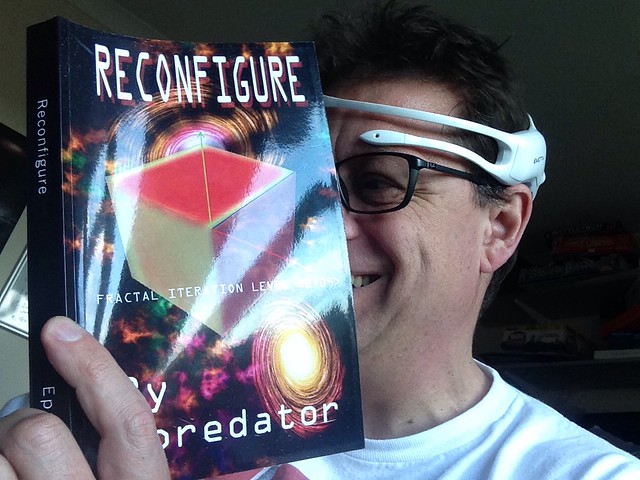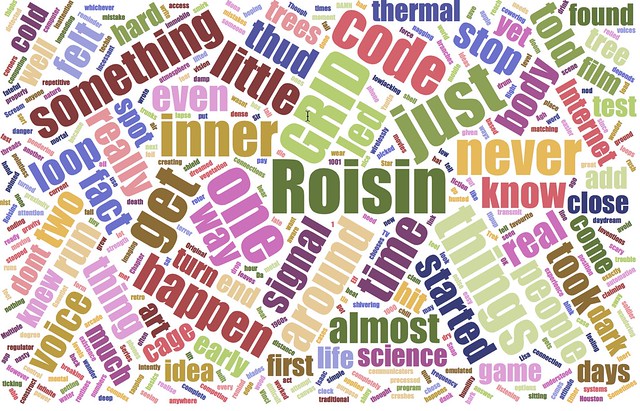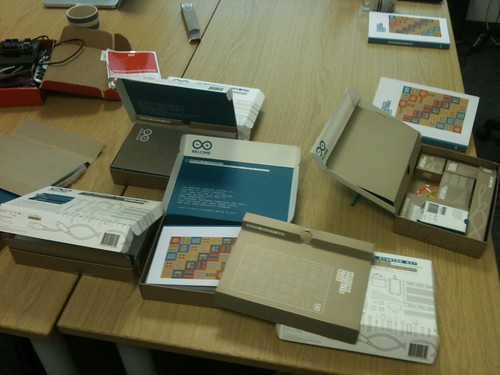Tomorrow I am heading to predlet 1.0 secondary school to talk to the year eight class (including predict 1.0) about programming, tech and interesting stuff like Internet of Things and what it is relevant to them. I am putting most of the same, but updated things in there to garner interest. The extra labelling of IoT to make things more relevant doesn’t alter the vector the the future I discuss is heading towards.
It is also a talk about how my career, or whatever this is called has flowed alongside new developments and of course I do also mention the book. It is relevant in several ways. The subject matter and being able to share and explain how a programmer’s mind or a gamer’s mind works is the obvious one. The ongoing story keeping up with and accelerating past the current technology, yet keeping it just possible is pretty much where I live as a technical evangelist. You have to know how things work, you have to be able to build things in order to help push things forward. Also the feedback loop of 3d printing creating objects that become inputs for IoT is still an incredible one to consider and share.
I also found that it became a relevant IoT(ish) example.
The book started as an idea, which became a digital product. Designed, published and sold from anywhere in the World. However, it became a physical object too. I was not planning that originally. The printed object takes up space and has a presence. A pile of them become things, not internet of things but things generated from the internet. They and the intangible ebook generate digital sales figures. Data that tuned for just me and my sales becomes the intelligence I act upon for the follow up book, for digital adverts etc. It also is part of the global sales figures, the charts the overall big picture from the big data on what is being read and sold. Products always have had this of course, but the figures are now instant. The ebook is able to be borrowed in a digital library and I get figures of how many pages have been read. The printed book can’t do that, yet. However, it could with the right devices as part of it. That would be useful for me, have people read it, where are they stopping, thinking time, heart rate for excitement, stress for complexity etc. The ebook is part way there, the physical is as far away as ever from that. The question then becomes, if we related that use case to something else would it be desirable and make sense to push the instrumentation further in the product.
Another gadget I may take with me is the Emotiv headset to show them. Oh! Look! it measures brain engagement, relaxation, stress etc. for the current activity. If it just knew which book, film, game I was reading, watching, playing then it could quite happily correlate and send this brain wave data to Amazon, on to the individual author, regardless of ebook or physical version. It could then also aggregate that all up into the big data picture.

I generated a word cloud of the first chapter to. Everyone knows what a word cloud is now I think, but it can be a relevant example of making sense or trying to make sense of massive amounts of data.

The instrumentation loop is here, the parts of it may not flow totally without friction but we can experiment with what might work, prototype then maybe build the proper versions.
I am also going to go a bit fractal thinking on them. Reminding them everything in computing is just adding up two numbers. The half adder circuit of an Xor and an And gate is the basis of it all. The number of times you it add up is what the computer leverages. From that spawns great complexity, and also great simplicity.
Then it’s Minecraft and python demo. Virtual world, code mixed maybe with a hololens video on the end, of Minecraft of course.
stemnet
Martial Arts, Science and Tech for Secondary School
Having returned for a great snowboarding and skiing holiday with the family,
I dived straight back into presenting and explaining science and tech. This was a slightly different request through STEMnet though. A local secondary school teacher asked if I could come and take about biomechanics and martial arts to try and help her students see why science is still an important subject to stick with.
I ran two sessions but built a new presentation specifically for this audience and reason.
Usually I am explaining tech, the future, metaverses etc but putting things like Choi Kwang Do and learning guitar into the mix to make things a little more human.
This time though the hook was martial arts. As Martial arts are not generally taught in school (though the should ideally be part of the curriculum) they are something that has a degree of intrigue to people. Choi Kwang Do in particular is based around a lot of ground up application of scientific principles. It is also not a combat sport, but a defence art aimed at improving your overall mental and physical well being. i.e. it’s idea; for this sort of talk.
I am not going to post the presentation as it featured a lot of video, very few words on slides and a lot of talking and demonstration.
The format though was….
1. Intro to who I am, what I do. I was wearing my Dobok and belt as part of the impact, but indicating my background and work as a techie. I also showed some custard pie throwing from The Cool Stuff Collective. My aim was to show that breadth of knowledge and experience is important and the ability to change is key.
2. I gave a potted history of CKD and showed some of the variety of people performing CKD. I showed predlet 1.0 in a video at a showcase event. It had all ages, sizes and abilities of people in it. The aim to remove the macho, teenage boys only, type of image and engage the entire class. I explained the classes that Master Scrimshaw runs in basingstoke too. I also had the values and pledge on screen to mention.
3. Next up was to talk about Psychology. In part this was about mental states. Dealing with the transition from relaxed, to wary to fight or flight. How the fight or flight state causes massive physical and chemical changes. How being aware of those changes, finding ways to avoid or positively use those is a fundamental part of any martial art. How being in the red and stressed when you don’t need to be will make you ill etc.
4. Physics was next. I pointed out that in a martial art Force = Mass x Acceleration is key. Learning ways to project as much of your mass as possible, as fast as possible is what the techniques are designed to do. Understanding forces and what they are apply to any sport, golf, football, tennis. However I also broke out into showing how we need to understand forces like gravity and cohesion in game development and animations. Here I was aiming to jump subjects to show that the same science and understanding is needing in something very physical and in something, like games development, that is more sat at a desk. The same science.
Also here I played a little trick. Whilst talking about the forces I suddenly jumped into stance and gave a very loud guttural kihap (Martial art shout). This made pretty much everyone jump. A fairly drastic pace change but the aim was to then remind everyone of the conversation about fight of flight earlier on. I pointed out that for me as the shouter, I had gained control, I had positive vibes and chemicals flowing and I was ready. For the class they were for a fraction of a second confused. Their body will have gone straight to code red, in fact jumping was part of fight or flight but almost taking them into tonic immobility, frozen in fear. A simple loud noise, out of context had caused metabolic changes in all of them. i.e. make the science personal and relevant.
Those that already did martial arts, there were a few in each class, were less bothered, seemed more relaxed as they were subconsciously dealing with the threat assessment.
5. I continued to talk about physics and relate that to biomechanics and anatomy. Understanding how to flow movements across your body to generate the acceleration.
6. This led to the neuroscience part. I shared how we learn patterns and sequential movement fits with the way the brain likes to absorb information. Moving from short to long term memory and able to operate when in flow mode works better if the thing you are learning has a completeness to it and a known pattern. In CKD we start and finish in the same place in most moves, we also follow a rounded non stressful sequence. Again I related this to video games and how we learn patterns to deal with situations in games. Discovering the pattern is the joy of play, followed by the mastery of that pattern, getting faster and better scores. Good games need to layer new patterns on old to avoid boredom. Likewise in CKD training we layer onto of mastered moves and patterns with new ones. At its root it all goes back to basics.
I also discussed contralateral movement, working the whole body on both sides for both parts of the brain to create cross hemisphere pathways as the brains neuroplasticity is exercised.
I used the example from Heston Blumenthal of the cinnamon and vanilla ice cream too. Again this was to break the subject, change the mental senses used by the group. With the ice cream made from both vanilla and cinnamon if you sniff cinnamon before tasting the ice cream you will only taste vanilla, like wise with vanilla sniffed first you will only taste cinnamon. This illustrates how you brain and neurochemistry is rigged to look for large changes. You brain filters things out to avoid overloading. The familiar is relegated in favour of the new.
I also discussed how the brain goes into an intense learning mode after a burst of exercise. This seems to be related to reflecting on what a situation was that caused you you be stressed and to escape, how you did it and how you won’t get eaten/killed/caught next time. So we can use our naturally evolved mechanism to increase out learning ability by piggy backing on that fight or flight calm down state.
7.Last up was metabolism. A basic example of the Krebbs cycle, the production and use of ATP as a mini fast access energy source in cells. I did not major on this but used it as a framework to discuss the 15 second bursts of exercise versus the 30 minute aerobic ones. In a defence situation you need to be explosive and able to release the ATP energy, quickly and efficiently and then get away. (Or not be there in the first place which is much better!)
Before heading into the last section I also shared the amazing journey of Sabunim Robbie Close. He went from a very quiet and shy teenage to an assistant instructor then a blackbelt and was then picked to go to Hanseo University in Korea to study a Degree in Choi Kwang Do. This martial art had transformed his outlook, and his life. We had the pleasure of him popping along to Basingstoke for a visit. As the class I was talking to was the age he was when he started it was great to have such a positive role model to share.
8.My final section moved more into the normal territory of discussion using the kinect to see how the body works. I related this again to biomechanics and then also to how we animate game characters and rig bones and joints. I ended up showing Microsoft HoloLens as a mandatory virtual world/metaverse, look here is the future and you can be part of it… the of conversation.
It was a very productive session I think on both occasions, and I hope to run some more. It covers all sorts of science and tech and it may help a few people see the relevance of science in life, or even better see the relevance of a martial art such as Choi Kwang Do.
Sharing Arduino experiences with STEMnet ambassadors
The STEMnet programme here in the UK enables people who are interested in sharing their expertise in STEM subjects with the next generation are given some support to do so. Schools ask their local STEMnet coordinator for help and volunteers step up and go along.
Yesterday at the Intech science centre (our local hub for STEMnet) I helped run an ambassadors intro into Arduino (and also a little bit of Scratch too).
Intech had bought 8 arduino starter kits. These are fantastic combinations of components and projects that have now become more official within the arduino community.

The packaging and collection of it is very professional and whilst still all based on open source it provide way more than I was expecting in the pack. Before seeing the kit I has thought we could start with the basics of the blinking light (a standard piece of code) using the onboard LED, then build the flashing light, then cut and paste and build 2. Basically following the 3 minute piece we did on Cool Stuff Collective
The basic presentation I used was this one, it was not designed to be overly pretty as it was just a catalyst to get things going.
I also did not know what the experience of each of the attendees was likely to be. As it was we had a great and helpful mix of people who knew lots, and were very advanced hardware engineers, some traditional IT professionals and programmers and some very enthusiastic newcomers to the subject (but technically literate)
***update 13:23 14/2 (Just uploading again as it seem the Slideshare conversion repeated some words and removed others!)
The aim of the pitch was to suggest the basics (inspired by the basics in Choi Kwang Do)
I thought most kids would want to be into programming initially because of games. There is an instant disconnect between seeing all the code and the effort for a AAA title that can be quite off putting.
So I settled on the light switch as a real world blended reality example. Layering on that the Arduino is a swicth we can control, but that the basics of input, process, output or sense, decide, respond are the fundamentals of everything. So if you get a basic piece of the experience dealing with getting some user input, deciding what to do and then making a change with an output you cover an awful lot of ground very quickly.
Very often as techies and engineers we all see the intricate detail, we become very aware of everything that we don’t know, how complex details can be. However if we treat the knowledge as a set of repeating patterns, like a fractal image we can talk about a basic building block without worrying about the complexity of the overall picture. After all you have to start somewhere.
Anyway, a huge thankyou to Sarah at Intech for hosting and for getting all the kit and for asking me to help in the first place 🙂 A huge thankyou to the group of Ambassadors that braved the potential snowstorm and dived and all had a go and got everything working in the few hours we had. It helped to debug what we need to tell students and other ambassadors.
